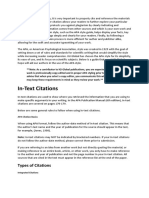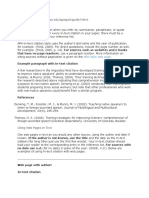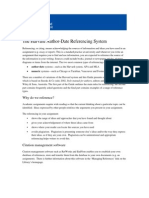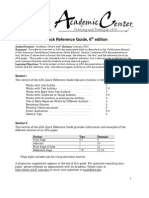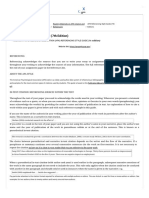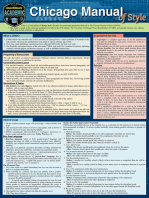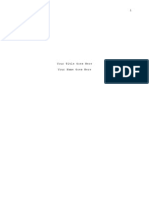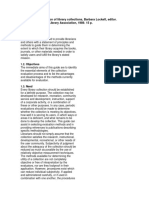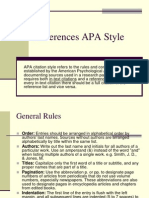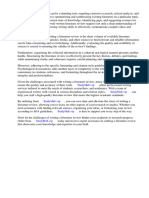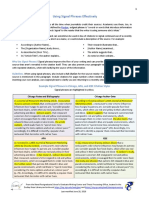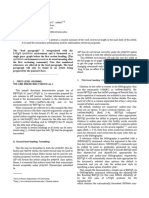APA Documentation and Formatting PDF
APA Documentation and Formatting PDF
Uploaded by
dhanuCopyright:
Available Formats
APA Documentation and Formatting PDF
APA Documentation and Formatting PDF
Uploaded by
dhanuOriginal Title
Copyright
Available Formats
Share this document
Did you find this document useful?
Is this content inappropriate?
Copyright:
Available Formats
APA Documentation and Formatting PDF
APA Documentation and Formatting PDF
Uploaded by
dhanuCopyright:
Available Formats
Writer's Web: APA Documentation and Formatting
http://writing2.richmond.edu/writing/wweb/apadocu.html
APA Style (6th Edition) (printable version here) APA (American Psychological Association) style is the standard method of publishing ones writing in psychology as well as other social sciences such as nursing, anthropology, sociology, business and gender studies (APA, 2010, p. xv). The following are highlights of some of the more important aspects of 6th Edition APA formatting, but do not constitute the whole of APA style. Please consult the manual (held on reserve at Boatwright Library) for a complete explanation of publishing guidelines. For an in-depth example of how an APA-style paper should look like, check out this Sample APA Paper for Students Interested in Learning APA Style 6th Edition by Dr. Jeff Kahn from the University of Illinois. In-Text Citations: General Guidelines When to cite You should cite authors who have directly influenced your writing, whether it be their ideas, theories, or empirical data. Citing an article implies that you have read the work you cited, so do not cite authors indirectly (i.e., citing author A whom you saw cited by author B, without reading author As paper). Cite any facts or figures that are not common knowledge. How many authors should you cite? For a standard empirical article, aim for 1 - 2 sources that best represent each key point you want to make. For a literature review, you will probably use more. This is because reviews are meant to introduce readers to the spectrum of information written about a certain topic. In-Text Citations: Format One Work by One Author Include authors last name followed by a comma, then the year of publication. If you are directly quoting an author, also include the page or paragraph number. Ending punctuation goes outside the parentheses. The study aimed to measure the participants' preferences in different types of music based on their age (Baker, 2008). If you mention the authors name in your sentence, then put the publication year immediately following the name. Baker (2008) measured correlations between age and music genre preference. One Work by Two Authors Include both authors' last names and the article's date of publication in parenthesis. Separate the authors' last names with an "&" rather than and. Follow the same rules as with one author. When citing more than two authors a second time, use the first authors surname followed by et al. (which means and others). Children have been shown to imitate the aggressive behaviors of adults as young as two years of age (Bandura, Ross & Ross, 1961). A classic study by Bandura, Ross and Ross (1961) showed strong evidence that children as young as two imitate the observed aggressive behavior of adults. Mean aggression scores for children exposed to aggressive adult models were significantly greater than those of children in non-aggressive or control conditions (Bandura et al., 1961). One Work by Six or More Authors From the get-go, cite only the last name of the first author, followed by et al, "and others," or "and colleagues."
1 of 5
20-08-2013 14:00
Writer's Web: APA Documentation and Formatting
http://writing2.richmond.edu/writing/wweb/apadocu.html
Nokes et al. (2012) found that nurses who used self-efficacy interventions for HIV patients showed a slight increase in patient adherence to retroviral treatment, though these effects were impacted by patient depression and lack of social capital. Groups as Authors When citing an organization as an author, write out the organization the first time they are cited and list the abbreviation in the parenthetical citation. A study by the National Institute of Mental Health (NIMH, 2003) found that... No Author Specified/Anonymous Works and Legal Documents For works with no listed author, or for legal documents, cite in text the first few words of the title. Use double quotation marks inside the parentheses for articles, webpages, or chapter titles; italicize titles of periodicals, books, brochures, or reports. total dollar amount (A Systematic Review, 2006) In the book Penny For Your Thoughts (1995)... (title should be capitalized in regular formatting) When an author is specifically listed as Anonymous, use that as the citation name. (Anonymous, 2001). More Than One Work in the Same Parentheses Order citations of two or more works within the same parentheses alphabetically, including citations that would otherwise shorten to et al. Separate works by a semicolon. Arrange two or more works by the same author(s) by date of publication. (Ellsworth, 2002; Rylie, Short, Morgan & Christoff, 1996; Wang, Peterson & Morphey, 2002; Wang et al., 2007). When citing more than one work by the same first author, add a suffix of a, b, c, etc. according to the order of works in the reference list. Several studies (Rylie, 2002a; Rylie 2002b; Melsworth & Rylie, 2003a, Mellsworth & Rylie, 2003b) suggest... In-Text Citations: Direct Quotes vs. Paraphrasing When and how to use direct quotes ()? Use when you are reproducing word-for-word information from others work or your own previous writings. This should be done sparingly. Also, use them when you are stating test items or participant directions verbatim. When using direct quotes, always list in parentheses the authors last names, year of the articles publication, and page number in this format: (Purcell, 1997, pp.111-112).* Direct quotes less than 40 words Put quotation marks around the quoted material, and incorporate the quote into your sentence. Try not to quote an entire sentence. If the quote is in the middle of your own sentence, end the quoted passage with quotation marks and put the parenthetical citation immediately after the passage, followed by any necessary punctuation. Then continue with the sentence as it would be normally. Since the quote is in the middle of this sentence (Zhou et. al, 2013, p. 10), I would format the sentence this way. If the quote comes at the end of the sentence, put the end quotation marks after the final word, insert the parenthetical citation, and end with the period (or exclamation/question mark, if youre getting fancy). Since the quote is at the end of this sentence, I would format the quote this way (Smith, 1992, pp. 10-12). Direct quotes more than 40 words Place the quote in a freestanding block of text on a new line, indented inch from the left margin. If there are subsequent paragraphs in your block quote, indent them another inch from the first indent.
2 of 5
20-08-2013 14:00
Writer's Web: APA Documentation and Formatting
http://writing2.richmond.edu/writing/wweb/apadocu.html
Place the parenthetical citation at the end of the block, after the end punctuation. Double-space all of the quote. Since my block quote had 40 words that you cant see here, Im going to end the quote this way. (Loving, 2000, pp. 111-115) If you mentioned the authors name in the sentence with the quote Only put the page number in parentheses if you already mentioned the authors name; always put the year immediately following an authors name when you refer to them in-text. Since Im mentioning Shields (2003) said something related to psychology, I only need to put the page number at the end of this sentence (p. 24). Directly quoting online material In your parenthetical citation, give the author, year, and page numbers if possible. If there is no pagination, refer to the paragraph a quote was taken from. Use the abbreviation para. Since I got this from a blog with no page numbers, Im going to cite using the paragraph number (Doling, 2005, para. 4). Other notes for quoting directly If there is incorrect spelling or grammar in your quotes, put [sic] immediately after the error, as to not confuse readers. [6.06] You may change the first letter in a quotation to be upper or lower-case in order to fit the syntax of your sentence. You may also change the punctuation mark at the end of a sentence to fit syntax. All other changes, including italicizing or omitting words, must be indicated. [6.07] Dont omit other authors in-text citations when quoting them. However, you dont need to have the included citation in your reference list, unless you directly cite them yourself. Note that this only applied to direct quotes, not paraphrasing. [6.09] Reference List: Ordering Guidelines Alphabetization Rules. Alphabetize by the authors last name, followed by the first and middle initial. Remember that nothing precedes something (e.g. Carter, T. S. precedes Carters, A. K.). Order of Several Works by One Author. Give the authors name in the first and following entries. Single-author entries by the same author are ordered by year of publication. Bargh, J. D. (1996). Bargh, J. D. (2003). Single-author entries come before multiple-author entries beginning with the same last name, regardless of publication year. Cooke, R. D. (1995). Cooke, R. D., Feders, G. K. & Tolman, E. M. (1984). Reference List: Formatting Guidelines References should contain the author(s') name(s), publication date, title, and publication information. For each cited work, list the authors in the order they are presented on the manuscript. The order of author names signifieswhat type of contribution they made to the work, and should not be alphabetized. If the reference is from an online source, include the DOI. This is a unique alphanumeric code assigned to online content, providing a permanent link to the information should the source url change. When a DOI is listed in your references, do not give any other retrieval information. The DOI should formatted like this: doi: xxxxxxx If no DOI has been assigned to the content, then provide the home page URL of the journal, book, or report author/publisher. Do not add any punctuation to the URL, such as a period at the end or a hyphen across line breaks. You do not need to include database information, or retrieval date information unless the content material has changed over time. Important note: When listing references, keep the first line left-aligned at the margin, and indent every line thereafter 1/2 inch. Due to online formatting restrictions we could not model the format here, but check the APA manual for an example. Books (not anthologies): Gregory, G., & Parry, T. (2006). Designing brain-compatible learning (3rd ed.). Thousand Oaks, CA: Corwin.
3 of 5
20-08-2013 14:00
Writer's Web: APA Documentation and Formatting
http://writing2.richmond.edu/writing/wweb/apadocu.html
Edited Book or Anthology Ruiz, V. L., & Snchez Korrol, V. (Eds.). (2006). Latinas in the United States: A historical encyclopedia. Bloomington: Indiana University Press. Chapter of a book by multiple authors: Beaudin, S. A., Gendle, M. H. & Strupp, B. J. (2012). Gender influences on the cognitive and emotional effects of prenatal cocaine exposure: Insights from an animal model. In Lewis, Michael and Kestler, Lisa (Eds.), Gender differences in prenatal substance exposure: A decade of behavior (pp. 77-96). Washington, DC: American Psychological Association. Journal Article, printed Williams, J. H. (2008). Employee engagement: Improving participation in safety. Professional Safety, 53(12), 40-45. Keller, T. E., Cusick, G. R., & Courtney, M. E. (2007). Approaching the transition to adulthood: Distinctive profiles of adolescents aging out of the child welfare system. Social Services Review, 81, 453- 484. Journal article, online version (With DOI) Senior, B., & Swailes, S. (2007). Inside management teams: Developing a teamwork survey instrument. British Journal of Management, 18, 138- 153. doi:10.1111/j.1467-8551.2006.00507.x (Without DOI) Senior, B. (1997). Team roles and team performance: Is there really a link? Journal of Occupational and Organizational Psychology, 70, 241-258. Retrieved from http://bpsjournals.co.uk/journals/joop Printed Newspaper article Smith, P. (2001, August 3). New drug appears to sharply cut risk of death from heart failure. The Washington Post, p. A12. Online Newspaper Article McHugh, P. (2005, March 17). Feeling down? It might help if you just take it outside. San Francisco Chronicle. Retrieved from http://sfgate.com Government Report National Institute of Mental Health. (1990). Clinical training in serious mental illness (DHHS Publication No. ADM 90-1679). Washington, DC: Government Printing Office. Other formatting notes: Wherever possible, we have used the latest edition of the APA Publication Manual: The left, right, top and bottom margins are all set to 2.54 cm, or 1 inch. The entire paper is double-spaced. All authors that you mention in the text must appear in your reference list, and all authors in your reference list must have been mentioned in your text. Rephrase sentences to avoid sexist language: for instance, use both "she" and "he" to reference hypothetical individuals. In most cases, the numbers zero through nine are spelled out, while the numbers 10 and above are written as numbers (see the APA manual for more specifics). Read over recent journal articles to get a sense of APA style.
Back to 'Documentation' Writer's Web | Writing Center | Make an Appointment | Library Copyright Info
American Psychological Association. (2010). Publication manual of the American Psychological Association (6th ed.). Washington, DC: American Psychological Association. Kahn, Jeffrey H. (n.d.). Sample APA paper for students interested in learning APA style 6th edition. Retrieved from my.ilstu.edu/~jhkahn
4 of 5
20-08-2013 14:00
Writer's Web: APA Documentation and Formatting
http://writing2.richmond.edu/writing/wweb/apadocu.html
/APAsample.pdf
5 of 5
20-08-2013 14:00
You might also like
- MLA PracticeDocument3 pagesMLA PracticeTanya50% (12)
- Literature Review Example CambridgeDocument8 pagesLiterature Review Example Cambridgeakjnbowgf100% (1)
- University of Ulster Business School Harvard Referencing GuideDocument12 pagesUniversity of Ulster Business School Harvard Referencing GuidePopa DanNo ratings yet
- 14 Apa Style GuidelinesDocument14 pages14 Apa Style GuidelinesNurul WahidaNo ratings yet
- Writing Seminar Session2 PDFDocument2 pagesWriting Seminar Session2 PDFdhanuNo ratings yet
- Using Transitions Effectively-1 PDFDocument4 pagesUsing Transitions Effectively-1 PDFdhanu100% (1)
- A Dose of Emptiness PDFDocument304 pagesA Dose of Emptiness PDFEliza KarpNo ratings yet
- APA 7th Edition 1Document81 pagesAPA 7th Edition 1Erika AfrielNo ratings yet
- APA Citation GuidelinesDocument20 pagesAPA Citation GuidelinesreoNo ratings yet
- APA Citation Guidelines EXEMPLE de ScriereDocument20 pagesAPA Citation Guidelines EXEMPLE de ScriereAndreea CristianNo ratings yet
- RESMETHAR Module 5 - Research Manual For Architecture 2022Document68 pagesRESMETHAR Module 5 - Research Manual For Architecture 2022Pau CruzNo ratings yet
- APA Format (Deakin University)Document9 pagesAPA Format (Deakin University)Muzzammil AyobNo ratings yet
- Citation WebDocument14 pagesCitation WebMichelle GoNo ratings yet
- Apa in Text Citations PDFDocument5 pagesApa in Text Citations PDFSteve MomanyiNo ratings yet
- APA 7 Referencing Short GuideDocument9 pagesAPA 7 Referencing Short GuideHà NguyễnNo ratings yet
- Stupid APADocument19 pagesStupid APAIshmaelNo ratings yet
- APA Format ReferencingDocument8 pagesAPA Format ReferencingBaquiran, Margaret Joice P.No ratings yet
- Unit 1 Module 1. Research ReferencingDocument8 pagesUnit 1 Module 1. Research ReferencingShiNo ratings yet
- APA Citations WorksCited2021UpdateDocument7 pagesAPA Citations WorksCited2021Updatestevan davisNo ratings yet
- General APA GuidelinesDocument12 pagesGeneral APA Guidelinespj10_rulesNo ratings yet
- APA - Cum Se Citeaza in APADocument5 pagesAPA - Cum Se Citeaza in APADarzan ConstantinNo ratings yet
- Apa In-Text CitationDocument6 pagesApa In-Text CitationSer OngNo ratings yet
- UNISA HarvardDocument13 pagesUNISA Harvardyenli881No ratings yet
- Unit 5.6 PPT - Apa StyleDocument32 pagesUnit 5.6 PPT - Apa StylerohmaNo ratings yet
- APA Quick Reference Guide, 6 Edition: Section IDocument16 pagesAPA Quick Reference Guide, 6 Edition: Section IgamerhobbistaNo ratings yet
- Oral and APA CitationDocument3 pagesOral and APA CitationRowan100% (1)
- How To Cite: In-Text Citation Style (Source: APA Style From Purdue OWL Online Writing Lab, 2015)Document7 pagesHow To Cite: In-Text Citation Style (Source: APA Style From Purdue OWL Online Writing Lab, 2015)Romy AmistadNo ratings yet
- In-Text Citations - The Basics - Purdue OWL® - Purdue University Text Ref 0Document4 pagesIn-Text Citations - The Basics - Purdue OWL® - Purdue University Text Ref 0Ariel EduardoNo ratings yet
- APA Citation BasicsDocument3 pagesAPA Citation Basicsashlie garciaNo ratings yet
- APA Citation and References Guide-6thDocument87 pagesAPA Citation and References Guide-6thBung NanoNo ratings yet
- Harvard Referencing GuideDocument14 pagesHarvard Referencing GuideDaren MansfieldNo ratings yet
- BU Guide To Citation in The Harvard Style: Available in Alternative Formats. Please AskDocument9 pagesBU Guide To Citation in The Harvard Style: Available in Alternative Formats. Please AskzyndarasNo ratings yet
- Referencing and CitationDocument9 pagesReferencing and Citationofficiallanarhoades16No ratings yet
- Harvard Guide To Citing ReferencesDocument37 pagesHarvard Guide To Citing ReferencesMagdalina MilanovaNo ratings yet
- Writing ReferencesDocument34 pagesWriting ReferencesSaud ShirwanNo ratings yet
- APA Citation BasicsDocument3 pagesAPA Citation BasicsRodger GregoryNo ratings yet
- APA Seventh Edition Sample PaperDocument8 pagesAPA Seventh Edition Sample PaperkeybateNo ratings yet
- Manual (I.e., APA 7), Which Released in October 2019. The EquivalentDocument5 pagesManual (I.e., APA 7), Which Released in October 2019. The EquivalentBelle GalindoNo ratings yet
- Apa FormatDocument17 pagesApa FormatCarrie Joy DecalanNo ratings yet
- APA 6th Edition CitationDocument6 pagesAPA 6th Edition CitationChristian AutorNo ratings yet
- Guidelines For APA StyleDocument21 pagesGuidelines For APA StyleAlemar ZerimarNo ratings yet
- APA Referencing Style Guide (7th Edition) - Reading Materials On APA Citation and Referencing - ENG102 - BIL Courseware - Bux - BRAC UniversityDocument16 pagesAPA Referencing Style Guide (7th Edition) - Reading Materials On APA Citation and Referencing - ENG102 - BIL Courseware - Bux - BRAC UniversityIbrahim AlifNo ratings yet
- Reference - APA - Citations & ReferencingDocument34 pagesReference - APA - Citations & ReferencingDennis IgnacioNo ratings yet
- APA Citation GuideDocument19 pagesAPA Citation GuideElizabeth PerezNo ratings yet
- Harward Essay GuideDocument11 pagesHarward Essay GuideHome TuitionNo ratings yet
- Rules On The American Psychological Association (Apa) Format and StyleDocument17 pagesRules On The American Psychological Association (Apa) Format and StyleJohn Lloyd Palaganas TulaganNo ratings yet
- Mla Formatting GuidelinesDocument5 pagesMla Formatting Guidelinesapi-189467016No ratings yet
- APA Quick Citation GuideDocument9 pagesAPA Quick Citation Guidejhalea ferrerNo ratings yet
- APA StyleDocument5 pagesAPA StyleJordan PickenNo ratings yet
- Apa 6th Thesis CitationDocument4 pagesApa 6th Thesis Citationjeannehallwinston-salem100% (3)
- BU Guide To Citation in The Harvard Style: Available in Alternative Formats. Please AskDocument8 pagesBU Guide To Citation in The Harvard Style: Available in Alternative Formats. Please AskHelder FigueiredoNo ratings yet
- Not Apa ReferencingDocument43 pagesNot Apa ReferencingInday BertaNo ratings yet
- Assignment On Referencing Styles (Essentials of Dissertation Writing)Document9 pagesAssignment On Referencing Styles (Essentials of Dissertation Writing)ridhigupta096868No ratings yet
- BU Guide To Citation in The Harvard Style: Available in Alternative Formats. Please AskDocument8 pagesBU Guide To Citation in The Harvard Style: Available in Alternative Formats. Please Askelwen1975No ratings yet
- Apa 6th Edition Citing Unpublished DissertationDocument4 pagesApa 6th Edition Citing Unpublished DissertationPaperWritingServicesReviewsCanada100% (1)
- 04.0 APA Style Citations and References August 2015Document28 pages04.0 APA Style Citations and References August 2015Rain BiNo ratings yet
- Bibme'S Free Apa Format Guide & GeneratorDocument14 pagesBibme'S Free Apa Format Guide & GeneratorAngel FamNo ratings yet
- APA Citation StyleDocument8 pagesAPA Citation Styleriderallison489No ratings yet
- Harvard Referencing Style GuideDocument12 pagesHarvard Referencing Style GuideJulian McEvoyNo ratings yet
- APA Citation BasicsDocument9 pagesAPA Citation BasicsAllan SobrepeñaNo ratings yet
- Different Citation StylesDocument3 pagesDifferent Citation StylesMary OsmenaNo ratings yet
- Writing Bibliography - in - Text CitationDocument32 pagesWriting Bibliography - in - Text CitationSidnee MadlangbayanNo ratings yet
- Apa Format Internal DocumentationDocument4 pagesApa Format Internal DocumentationsenyorakathNo ratings yet
- Chicago Manual Of Style Guidelines: Quickstudy Digital GuideFrom EverandChicago Manual Of Style Guidelines: Quickstudy Digital GuideNo ratings yet
- Paragraphs Academic Writing PDFDocument2 pagesParagraphs Academic Writing PDFdhanuNo ratings yet
- Being Critical PDFDocument4 pagesBeing Critical PDFdhanuNo ratings yet
- Signal Phrases PDFDocument1 pageSignal Phrases PDFdhanuNo ratings yet
- Additional Editing Exercises PDFDocument8 pagesAdditional Editing Exercises PDFdhanuNo ratings yet
- Identifying Verbs and Their Subjects PDFDocument2 pagesIdentifying Verbs and Their Subjects PDFdhanuNo ratings yet
- Exercises On Paragraph WritingDocument9 pagesExercises On Paragraph WritingNajia Zaheer NazirNo ratings yet
- Power Introductions Address The Audience at Beginning of Prompt or in IntroductionDocument2 pagesPower Introductions Address The Audience at Beginning of Prompt or in IntroductiondhanuNo ratings yet
- Parallel StructureDocument2 pagesParallel StructuredhanuNo ratings yet
- Double Negatives PDFDocument2 pagesDouble Negatives PDFdhanuNo ratings yet
- The 6 Traits of Writing: Ideas Organization Word Choice Sentence Fluency Voice ConventionsDocument17 pagesThe 6 Traits of Writing: Ideas Organization Word Choice Sentence Fluency Voice ConventionsdhanuNo ratings yet
- Top Ten Rules of WritingDocument2 pagesTop Ten Rules of Writinggogolee2013No ratings yet
- Powerful Body ParagraphsDocument4 pagesPowerful Body ParagraphsdhanuNo ratings yet
- Summary: Using It Wisely: Assignment AudienceDocument5 pagesSummary: Using It Wisely: Assignment AudiencedhanuNo ratings yet
- Strong Body ParagraphDocument3 pagesStrong Body Paragraphapi-261481345No ratings yet
- The Writing Center PDFDocument7 pagesThe Writing Center PDFdhanuNo ratings yet
- BIZ102 - Assessment 1 Brief - 072020Document6 pagesBIZ102 - Assessment 1 Brief - 072020ahmerNo ratings yet
- DPCI Reference Manual: STN Online User GuideDocument101 pagesDPCI Reference Manual: STN Online User GuideRamNo ratings yet
- Las 3Document9 pagesLas 3Carl DoriaNo ratings yet
- Activity Sheets in Text CitationDocument2 pagesActivity Sheets in Text Citationvierneskennethjoseph32No ratings yet
- CBE Template WordDocument4 pagesCBE Template Wordmy free term paper100% (1)
- ENGL202 - Portfolio Project Directions and RubricDocument13 pagesENGL202 - Portfolio Project Directions and RubricRamizNo ratings yet
- Synthesis WritingDocument7 pagesSynthesis WritingKamesha WoolcockNo ratings yet
- Rubric Analytical Writing and SpeakingDocument2 pagesRubric Analytical Writing and Speakingagung s100% (1)
- Thesis Project Report Format BSC CSE HSTUDocument20 pagesThesis Project Report Format BSC CSE HSTUMD NUR ALAMNo ratings yet
- APA 7 ReferenceDocument4 pagesAPA 7 Referencemaiwandmoheb123No ratings yet
- ALA Guía de Evaluación de Colecciones de BibliotecaDocument19 pagesALA Guía de Evaluación de Colecciones de BibliotecaDanna VirgilioNo ratings yet
- How To Write A Research PaperDocument6 pagesHow To Write A Research PaperRaja RajaNo ratings yet
- APA Style - PPT NewDocument14 pagesAPA Style - PPT NewAbeer EwainehNo ratings yet
- Citing ReferencesDocument13 pagesCiting ReferencesjustinohaganNo ratings yet
- Example of Apa Literature Review AbstractDocument6 pagesExample of Apa Literature Review Abstractafmzwasolldhwb100% (1)
- PHD Dissertation Topics in LeadershipDocument6 pagesPHD Dissertation Topics in LeadershipWriteMyCollegePaperForMeSingapore100% (1)
- PANDUAN SITASI DAN REFERENSI Ilkom Bakrie 2021Document32 pagesPANDUAN SITASI DAN REFERENSI Ilkom Bakrie 2021Yohanes PangaribuanNo ratings yet
- How To Write An EssayDocument6 pagesHow To Write An EssayMelisa Santamaria100% (1)
- Academic Writing and Critical ThinkingDocument87 pagesAcademic Writing and Critical ThinkingAbhishek JoshiNo ratings yet
- Using Signal Phrases EffectivelyDocument3 pagesUsing Signal Phrases EffectivelyPatricia AndesNo ratings yet
- Referencing - Harvard Method. Library GuideDocument7 pagesReferencing - Harvard Method. Library GuideLuca SelvaggioNo ratings yet
- Literature Review Example RmitDocument8 pagesLiterature Review Example Rmitc5ha8c7g100% (1)
- General Instructions:: 1. Read The Passage Given BelowDocument6 pagesGeneral Instructions:: 1. Read The Passage Given BelowSubhamkumarsinghNo ratings yet
- Microteaching Lesson PlanDocument4 pagesMicroteaching Lesson Planapi-404825855No ratings yet
- Legal MemorandumDocument12 pagesLegal MemorandumBianca BncNo ratings yet
- Accounting Seminar Paper Lecture NotesDocument10 pagesAccounting Seminar Paper Lecture Noteschumbefred100% (1)
- Template For Submission To AIP Publishing Journals 2Document6 pagesTemplate For Submission To AIP Publishing Journals 2shivaprasad047No ratings yet









